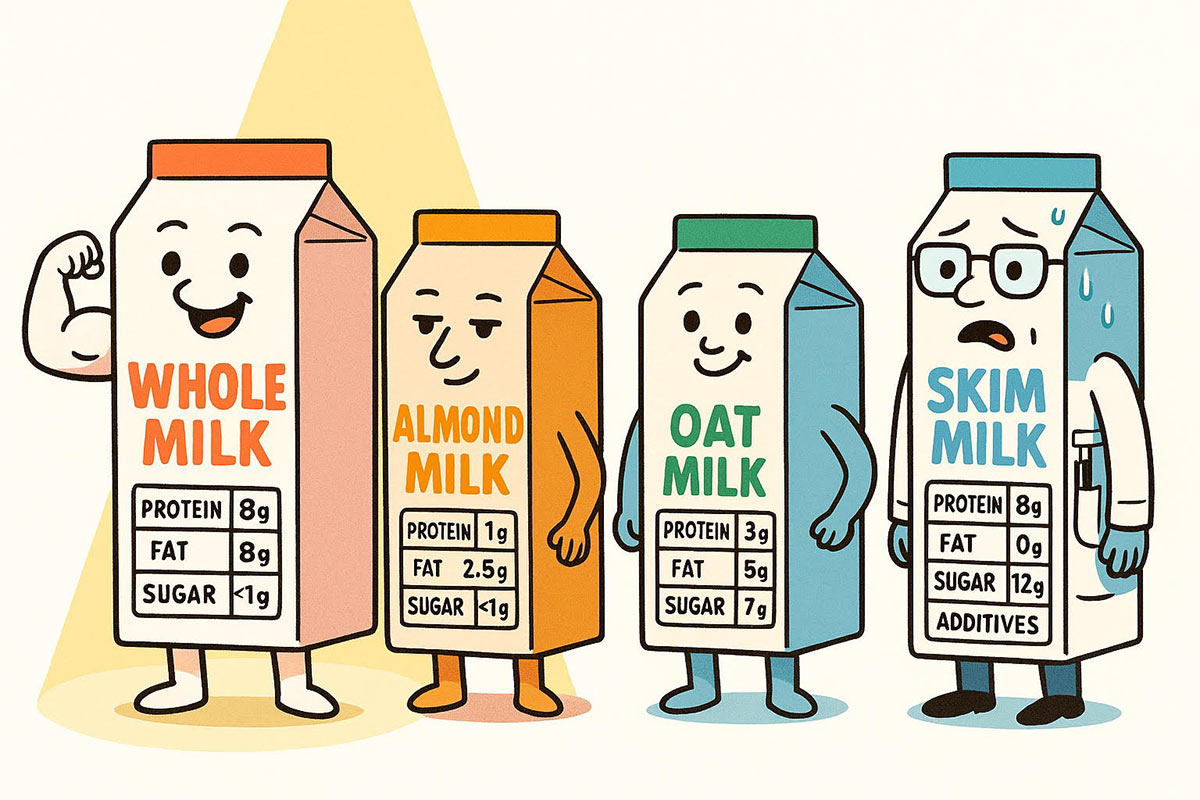By Kumar Da for Hopium Health
Let’s face it. The milk aisle these days looks like the United Nations of beverages. Almond, oat, pistachio, buckwheat, cashew, coconut… You half expect to see a U.N. interpreter explaining the peace treaty between rice milk and a soy latte.
But the question remains:
What’s actually in these things? Are they healthy? And where does that leave old-fashioned cow’s milk?
Whole Milk: The Old-School Legend
Whole milk is the original supergroup. No remix needed.
- Protein: 8g per cup
- Fat: Yes, including saturated fat—but it helps with vitamin absorption and satiety
- Nutrients: Calcium, Vitamin A, D, potassium, phosphorus
- Bonus: It’s real food. No chemistry degree needed.
Unless you’re lactose intolerant or vegan, a splash of whole milk is no crime. In fact, it might be the healthiest white liquid in your fridge.
Skim Milk: The Frankenstein of Dairy
Skim milk started with good intentions: “Let’s take the fat out!”
What followed was a lab experiment worthy of Dr. Jekyll.
- Fat removed? Yes.
- Flavor removed? Also yes.
- So what did they add?
- Carrageenan
- Gums and starches
- Synthetic vitamins
- Texture trickery
Dr. Tim Spector calls this gut confusion in a carton—spiking blood sugar and messing with your microbiome. You feel less full and more snacky. That’s not health—it’s hunger with a lab coat.
Plant-Based Milks: Wellness or Whitewashed Water?
Here’s what they don’t tell you: Most plant milks are just flavored water with a PhD in marketing.
Let’s break it down:
Almond Milk
- Made with: Water + 2–5% almonds (yes, that little)
- Pros: Low-calorie, Vitamin E
- Cons: Virtually no protein, heavily processed, and high water usage in farming
Oat Milk
- Made with: Oats + enzymes + water
- Pros: Creamy, some fiber (if lucky), often fortified
- Cons: Often loaded with sugars, can spike blood sugar
Pistachio Milk
- Bougie and trendy
- Rich in fats, poor in protein
- Mostly for showing off at brunch
Buckwheat Milk
- A sleeper hit
- Higher in fiber and protein than almond milk
- Naturally gluten-free and less sugary
But What About Nutrients?
Whole milk delivers protein, fat, calcium, A & D vitamins—a full meal in a glass.
Most plant milks are fortified to imitate these benefits.
| Milk Type | Protein | Sugar/Carbs | Fat | Fortified? | Real Nutrition? |
|---|---|---|---|---|---|
| Whole Milk | 8g | 12g (lactose) | 8g | Yes | Yes |
| Skim Milk | 8g | 12g | 0g | Yes | (processed) |
| Oat Milk | 2–4g | 16–20g | 1–5g | Yes | (watch sugar) |
| Almond Milk | 1g | <1g | 2.5g | Yes | (low almonds) |
| Pistachio Milk | <2g | Varies | 5g+ | Sometimes | (pretty, not potent) |
| Buckwheat Milk | 2–3g | Moderate | 2g | Yes | (niche winner) |
Hopium Health’s Milk Manifesto
“Not all white liquids are equal. Some come from cows. Some come from almonds pretending to be cows.”
If you tolerate dairy:
Choose whole milk (in moderation). It’s a nutrient-dense, time-tested food.
If you’re plant-based:
Pick unsweetened, fortified, and clean-label milks. Bonus points for higher protein like pea or buckwheat blends.
Avoid:
Gums, emulsifiers, corn starch, barista blends with oils
“Low-fat” skim milk with high sugar consequences
And remember:
“The fewer ingredients, the better your microbes will feel.”








